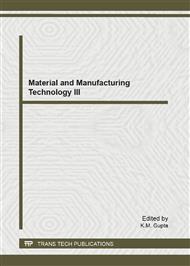p.551
p.555
p.560
p.566
p.571
p.576
p.581
p.586
p.591
Analysis on Melting Mechanism in the Cross Section of Co-Rotating Twin Screw Extruder
Abstract:
In this paper, melting process in a co-rotating twin screw extruder was studied based on two dimensional melting model of flow field cross section. Positive displacement conveying characteristic in the melting section was assumed and melting process of each section was regarded as the result of time evolution. Procedure of melting was analyzed according to experiments and numerical simulations, both indicating that solid materials in the flight zones would melt firstly and carcass wrapped in the middle of melt would be molten finally. Liquid fraction contours showed that flow of hot melt played an important role in the melting process of cross section. Four types of melting mechanisms were summarized, in which viscous dissipation heat was discussed in detail, showing that viscous dissipation contributed about 10%-30% to the total energy needed during melting. Screw speed affected viscous dissipation significantly, while heating flux of barrel had little influence on it.
Info:
Periodical:
Pages:
571-575
Citation:
Online since:
July 2012
Authors:
Keywords:
Price:
Сopyright:
© 2012 Trans Tech Publications Ltd. All Rights Reserved
Share:
Citation:


